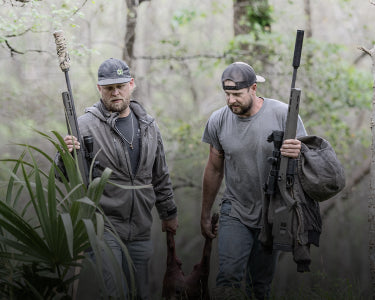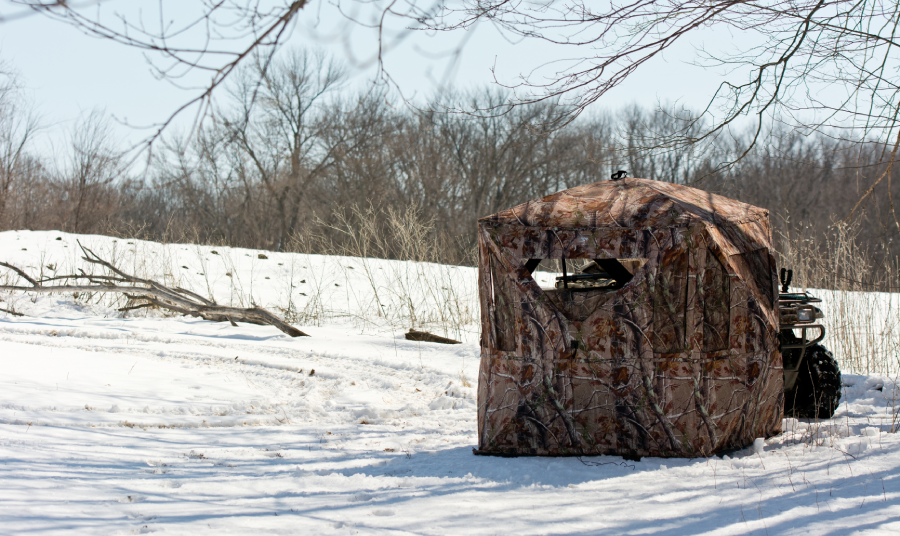To put it bluntly, being cold sucks. If you are not properly prepared, you are left in your tree stand shivering, losing fine motor skills by the minute because you failed to bring along gloves… or perhaps you did but you clumsily dropped them out of your stand. If you're lucky, you are hunting from a blind which protects you from the onslaught of wind, but that's about it as the cold cuts through you like a hot knife through butter. One of the worst mistakes one can make is to overdress when it is cold. Now, that doesn't mean leaving layers back in the hunting cabin but instead means knowing what to wear and when. Sweating when temperatures are cold or even below freezing is a recipe for disaster, and hypothermia if you're not careful. Read on as we talk about some essential pieces to consider adding to your kit to ensure a warm hunt all winter long.
Choose a Fog-Proof Riflescope for Cold Weather Conditions
Before we get into creature comfort, first thing’s first… glass. With temperatures varying greatly between first light and last light, you're going to want a riflescope that is fog proof. Poorly built optics will fog up as soon as temperatures start to fluctuate between extremes, rendering you blind as you're unable to see your target. The good news is you'll be able to go back to being warm indoors. The bad news is your dreams of that trophy buck are now just that… a dream. Invest in a quality optic and save yourself many headaches and heartaches. For example, the Core HX 3-12x56 HDR Hunter Dot Rifle Scope. This scope is simple and provides just what a hunter needs, without being overloaded with bells and whistles that do nothing but increase costs. Clear glass, wide magnification range, and terrific light transmission are amongst what you should expect, as well as one of the key aspects of good glass we mentioned earlier… the capability to remain fog proof through temperature changes.
Coveralls: All-In-One Protection Against the Cold

Perhaps my favorite piece of gear I own is a set of insulated coveralls. Covering your entire body, this piece of gear ensures your exposure to the elements is minimal, helping to maintain body heat. They’re also designed with a durable, weather-resistant material that protects you from rain, snow, and wind, ensuring you stay dry and comfortable throughout the hunt. While designs may vary based on the manufacturer, you can expect certain features such as an array of pocket options and zippered legs making it easy to take boots on and off. Choose a pair of coveralls that’s one size up from what you normally wear to allow room for additional layers underneath.
Balaclavas: Face and Neck Protection in Bitter Winds

When the winds are blowing, don’t forget to cover your face. Doing so with a balaclava will shield not only your face but your neck as well from harsh winds and potential frostbite while maintaining overall body warmth as you sit in anticipation of deer. Balaclavas are typically made from insulating materials like fleece or merino wool, which keep heat close to the skin while wicking away moisture. Remember… the key here is to not sweat, but remain warm and comfortable. A snug fit allows for easy layering under other headgear like a warm winter hat or the hood of your hunting jacket.
Heated Mittens: Keep Dexterity Without Freezing Your Hands
When your hands and fingers are cold, you can kiss your fine motor skills goodbye. Even hot hands stashed in pockets will only go so far as to provide a level of warmth that leaves you both comfortable and functional. Heated mittens are a game-changer for those facing frigid temperatures, and having a constant heat source to keep your hands warm is priceless. While different brands and models may vary, they all in essence have an integrated heating element that provides targeted warmth, while the flip-top feature of the mittens allows you to quickly access your firearm. Despite what you have thought in the past, it is indeed possible to enjoy the benefits of warmth without sacrificing functionality.
Insulated Hunting Boots: Your First Line of Defense Against the Cold Ground

If you want to put yourself on the fast track to being miserable, go out hunting in below-freezing temperatures in a pair of boots not built for the conditions you plan to sit in potentially all day. When searching for a pair of boots, first determine the conditions you anticipate hunting in, and when in doubt, opt for a cooler temperature rating. The boots you ultimately end up selecting should provide enough insulation to keep your feet warm while being able to whisk away moisture. Waterproof options should be at the top of your list, especially if your path requires you to cross a small stream, or even if it should begin to snow. Traction is important as well, so go with an aggressive outsole to help prevent falls on slick ground. Lastly, when trying on boots be sure to do so with the same socks you plan on wearing during the hunt, as they’re most likely made from a thicker material than your run-of-the-mill daily sock you’d wear with gym shoes.
Portable Heaters: A Must-Have for Blind Hunts

A portable heater in a hunting blind can be a game-changer for those taking part in cold-weather hunts. Typically fueled by small propane canisters found in the camping aisle of your local big-box store, they provide a reliable source of warmth, helping to take the edge off otherwise miserable conditions. A portable heater is worth its weight in gold for warming up fingers and toes while taking up minimal space in your blind, inevitably keeping you in the woods longer because of the comfort it provides.
Thermal Base Layers and Warm Socks: The Foundation of Every Winter Kit

Dressing in layers is a must, as you want to be able to peel off layers or add on with ease. You’ll want to wear less clothing on your hike into the woods the morning of your hunt to avoid sweating, as this will end your hunt faster than anything you’d dream up. When selecting a base layer, search for materials that offer moisture-wicking capabilities. Merino wool or advanced synthetic blends are known for their ability to regulate body temperature effectively. The base layers you choose should sit close to your skin without restricting movement. Odor-resistant properties are worth looking into as well, especially for extended hunting trips where changing clothes or washing them in between sits may not be an option. The same features you look for in your base layers transfer over to choosing warm socks to wear during your hunt, with Merino wool once again being a key fabric that many hunters opt for when shopping for gear.
Final Thoughts on Late Season Deer Hunting Gear
While hunting during the winter offers a unique set of challenges, with the right gear you can stay warm and comfortable despite what mother nature may be throwing your way. From head to toe and everything in between there are countless products available to help you brave the cold. By investing in quality gear tailored for cold-weather outdoor use, you’ll ensure that you continue to get out into the woods year after year, perhaps even getting a shot at that deer you’ve been tracking on your trail camera for the past few months!
Have a great outdoor adventure story? Share it with us! Accepted stories will receive a 20% discount code.
Frequently Asked Questions
Why is it important to choose a fog-proof riflescope for cold weather conditions?
A fog-proof riflescope prevents fogging up due to fluctuating temperatures, ensuring clear visibility of your target throughout the hunt.
What are the benefits of wearing insulated coveralls for late season deer hunting?
Insulated coveralls provide full-body protection from the elements, helping to maintain body heat and keeping you dry and comfortable in cold, snowy, or rainy conditions.
How should one choose the right size of coveralls for late season hunting?
It is recommended to choose coveralls one size up from your regular size to allow room for additional layers of clothing underneath, ensuring maximum comfort and warmth.
Why is it important to wear a balaclava during late season deer hunting?
Wearing a balaclava protects your face and neck from harsh winds and potential frostbite, helping to maintain overall body warmth while waiting for deer in cold weather conditions.
What are the key features to look for in a quality riflescope for hunting in cold weather?
Clear glass, wide magnification range, excellent light transmission, and fog-proof capabilities are essential features to consider when choosing a quality riflescope for hunting in cold weather.





